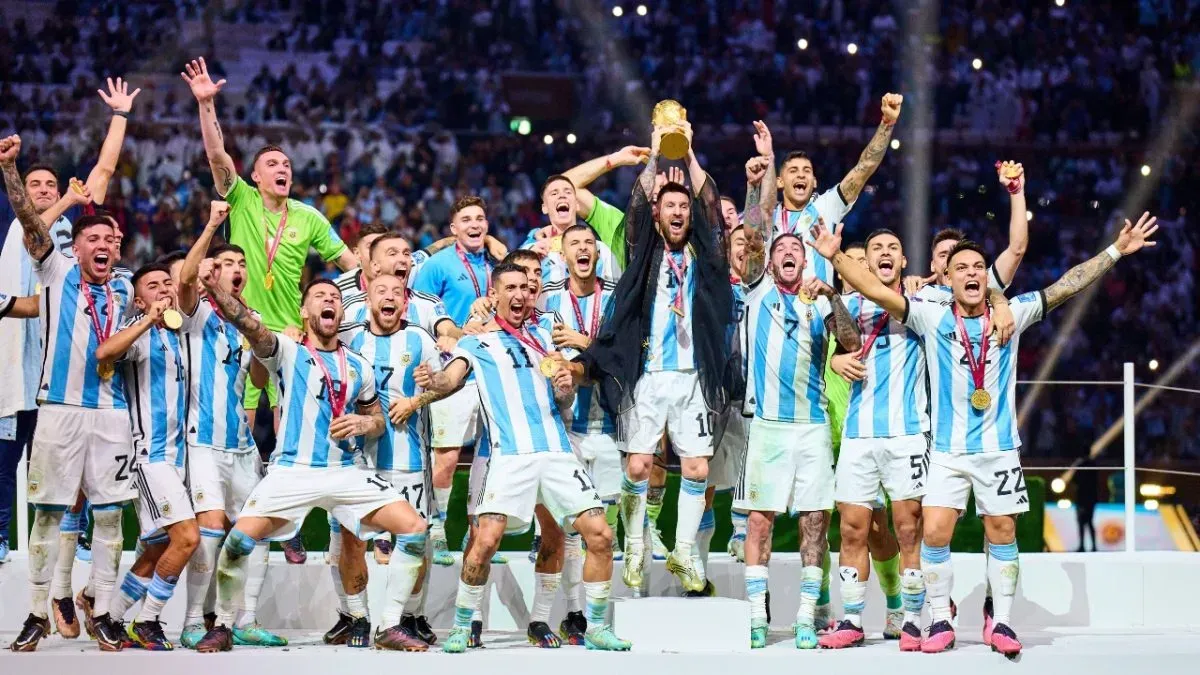World Cup 2026 TV schedule
This World Cup TV schedule has everything you need to know about the biggest sporting event on Earth.
Where to watch the World Cup on TV?
World Cup 2026, like those of 2018 and 2022, is live across FOX and FS1 (English-language) plus Telemundo and Universo (Spanish-language). All World Cup games are shown live across streaming services fuboTV, Peacock TV, Sling TV, and YouTube TV.
Watch the World Cup on Fubo:
Our Pick:Includes: Premier League, Liga MX, Ligue 1, + 84 Sports Channels |
 |
Pro Tip: To make sure you don’t miss a match, download the Soccer TV Schedules App that includes listings of all of the live soccer matches available in the United States (available on Apple iOS devices and Android devices).
Also, courtesy of World Soccer Talk, download a complimentary copy of The Ultimate Soccer TV And Streaming Guide, which features details on where to watch all of the leagues from around the world on US TV and streaming.
As the 2026 World Cup nears, there will be new developments in regard to the full schedule. Teams and actual time slots are not confirmed until just months before the World Cup. However, the format should smooth out in the years leading up to the competition.
When is the next World Cup?
After Argentina defeated France in the 2022 World Cup Final, heads already started turning to 2026. That tournament, hosted jointly by the USA, Mexico and Canada, kicks off in the summer of 2026. There are no specific dates lined up yet. However, it is a return to the more traditional timing of June to July. The previous World Cup was the first to take place outside that time frame, as it went from November through December.
The 2026 World Cup also has a number of changes. There will be 48 teams competing, up from 32 in 2022.
It is the second time the United States is the host, and the third for Mexico. Canada, on the other hand, only has experience with a Women’s World Cup. Yet, that is valuable experience for a country hosting its first men’s World Cup.
2026 HOST CITIES
Sixteen host cities across the three nations have been selected and broken into three regions – East, Central, and West. Half of the venues usually use artificial turf, but will have natural grass playing surfaces installed for the tournament.
Guadalajara (Estadio Akron), Los Angeles (SoFi Stadium), San Francisco Bay (Levi’s Stadium), Seattle (Lumen Field), and Vancouver (BC Place) make up the West region.
Atlanta (Mercedes-Benz Stadium), Dallas (AT&T Stadium), Houston (NRG Stadium), Kansas City (Arrowhead Stadium), Mexico City (Estadio Azteca), and Monterrey (Estadio BBVA) are the Central hosts.
And in the East, matches will be staged in New England (Gillette Stadium), Miami (Hard Rock Stadium), New Jersey/New York (MetLife Stadium), Philadelphia (Lincoln Financial Field), and Toronto (BMO Field).
Several of the host cities have hosted World Cup games in past tournaments. However only one stadium has been used before – Estadio Azteca. None of the stadiums from the 1994 World Cup are being used. Three no longer exist, and the rest were either not submitted as potential hosts and/or passed over in favor of more modern facilities. Toronto’s BMO Field will be the only World Cup venue that was specifically built for an MLS team. But four others are the regular home venues for MLS sides. And every stadium in the tournament has hosted high-level soccer matches in some capacity in the past.
Vancouver hosted matches at the 2015 FIFA Women’s World Cup, but 2026 will be Toronto’s first World Cup games of any sort. BMO Field will be expanded for the tournament to meet seating capacity requirements.
World Cup History
For almost a century, the history of the FIFA World Cup captivated supporters across the world. It is, after all, the ultimate event in the world’s most popular sport. The competition began modestly with the goal of bringing people together through sport and has since grown into a massive spectacle that attracts billions of viewers.
Nothing in soccer can rival the prestige of the World Cup. While the UEFA Champions League may deliver games of similar quality, it falls short of the status earned by the World Cup due to its long-standing tradition and the unique aspect of one team representing an entire country.
Supporters journey from various corners of the globe to witness their preferred teams play against some of the world’s most skilled soccer players. Teams representing Africa, Asia, Europe, North and Central America, and the Caribbean, Oceania, and South America compete in the World Cup. In addition, in terms of significance, no other sports event can compete.
The World Cup stands as the most prestigious soccer tournament globally, recognized as the most extensively watched and followed single sporting event across the world. The 2018 World Cup pulled in about 3.57 billion viewers, which is nearly half of the global population. In comparison, engagement with the 2022 World Cup hit 5 billion. Approximately 1.5 billion individuals tuned in for the final match.
Qatar hosted the 2022 World Cup, making it the most recent of 17 countries to host the competition. Mexico will hold the unique distinction of being the first nation to host games in three World Cups when it co-hosts the 2026 event with the United States and Canada.

Argentina is the defending World Cup champion. A win over France in Qatar in 2022 was the third title for the South American nation.
The idea behind the World Cup
Scotland vs. England was the world’s first international soccer match, which took place in Glasgow in 1872. England, Scotland, Wales, and Ireland competed in the first-ever British Home Championship, the first-ever international competition for nations held in 1884.
In the early 1900s, soccer gained popularity in various regions of the world. It was a demonstration sport at the Summer Olympics, with no medals given out in 1900 and 1904.
FIFA attempted to set up an international soccer competition in 1906 in Switzerland amongst countries not affiliated with the Olympic Games after it was established in 1904. International soccer was still in its infancy during these times, and the first preview of what a World Cup could be was deemed a failure by FIFA’s official history.
Soccer gained formal Olympic status in 1908 during the Summer Olympics in London. The Football Association (FA) is responsible for overseeing soccer in England. The FA organized the event. Yet many viewed it as a show, not a competition. This tournament exclusively featured amateur athletes.
In 1909, Sir Thomas Lipton organized the Sir Thomas Lipton Trophy tournament in Turin, although the Olympic event remained an amateur competition. Several clubs from various countries competed in the Lipton competition, each of which represented a whole nation – these clubs were not national teams.
It was contested by the most elite professional club teams from Italy, Germany, and Switzerland, and is frequently referred to as “The First World Cup.” The Football Association of England, however, turned down the invitation to send a professional squad and refused to be connected to the event.
Because of the Olympics’ ban on professional athletes, a global tournament featuring the best teams in the sport was badly needed. The game was going through a professionalization process in the 1920s that was not in line with the Olympic ideals. As a result, FIFA, the government organization, started planning to host a World Cup. On May 26, 1928, the decision to organize the inaugural edition was formally announced.
Inaugural tournament and how it came to be
Since its first event in Uruguay in 1930, the World Cup has been contested every four years. There were a pair of interruptions due to World War II. Now, the World Cup serves as a symbol of togetherness and joy for a host country. It welcomes the world to get a taste of its culture.
Contrast the magnificent event we know now with the humble beginnings of the World Cup. There were 13 teams in the tournament. Hosts Uruguay came out on top following a 4-2 victory against Argentina in the championship match.
In any case, the tournament’s triumph paved the way for a worldwide soccer revolution. Since then, the World Cup has become a scheduled event. Supporters rejoice in the spirit of teamwork and competition every four years.
The competition experienced an unexpected pause during World War II. Worldwide struggle canceled the 1942 and 1946 tournaments. The 1950 edition, held in Brazil, became a symbol of optimism and healing. The tournament pioneered a new group stage structure. In that same tournament, Uruguay famously upset Brazil in the final. Roughly 200,000 fans at the Maracana Stadium in Rio de Janeiro watched the “Maracanazo.”

Pele helped Brazil win its first World Cup title in 1958. His hat trick in the final against Sweden set up arguably the best international career of all time.
Before 1978, only 16 teams competed. In 1982, there were 24 teams; in 1998, that number doubled to 32. Starting in 2026, there will be 48 teams competing in one event. There will be a total of 16 groups, each with three teams.
From 1930 until 1970, the tournament’s winner took home the Jules Rimet Trophy. That commemorated the Frenchman who first came up with the idea for the competition. In 1970, Brazil became the first team to lift the trophy three times. Brazil ended up keeping the Jules Rimet trophy. Therefore, FIFA brought a new trophy to the World Cup.
World Cup: 21 century and modern history
Germany, Italy and France rose to prominence in the 1990s and 2000s. In 1998, with the increase to 32 teams, the tournament became more than just a soccer competition; it also served as a forum for diplomatic and cultural interaction.
South Africa hosting the 2010 World Cup was the first time for an African country. Enthusiastic fanfare, the unmistakable sound of vuvuzelas and Spain’s innovative tiki-taka style brought an unforgettable tournament. This demonstrated the power of soccer’s World Cup to bring together people from all walks of life.
Nearing its centennial, the FIFA World Cup is a symbol of the power of sports to bring people together. The World Cup has grown from its humble origins in Uruguay to the worldwide spectacle it is today. Now, it is an indelible part of the fabric of human culture. Beyond the excitement of competition, it has functioned as a cultural bridge, building understanding and solidarity across cultures.
Photos: Imago














